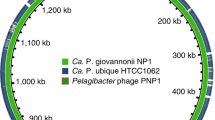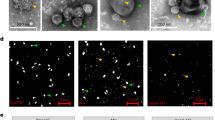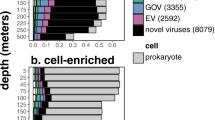Abstract
Viral infection of bacteria can be lytic, causing destruction of the host cell, or lysogenic, in which the viral genome is instead stably maintained as a prophage within its host1. Here we show that lysogeny occurs in natural populations of an autotrophic picoplankton (Synechococcus) and that there is a seasonal pattern to this interaction. Because lysogeny confers immunity to infection by related viruses1, this process may account for the resistance to viral infection seen in common forms of autotrophic picoplankton2.
Similar content being viewed by others
Main
We undertook a seasonal study in Tampa Bay, Florida, of prophage induction in cyanobacteria over the year ending in October 2000 to find out whether lysogeny occurs in natural Synechococcus populations and, if so, how it is affected by changing environmental conditions.
Cyanophage abundance was determined by serial dilution on microtitre plates with addition of the host organism Synechococcus st. CCMP 1334 (WH7803, DC2); data were processed by using a most-probable-number (MPN) program3. SYBR gold staining followed by epifluorescence microscopy4 confirmed the presence of viral particles in wells containing lysed cells. To determine whether lysogens were present, we assayed water samples for prophage induction using mitomycin C as the inducing agent. A viral-reduction technique5 was used in the preparation of samples to increase the sensitivity of the assay.
A statistically significant amount of prophage induction in natural populations of Synechococcus was revealed on six occasions in response to exposure to mitomycin C (Fig. 1). Prophage induction, measured as the percentage change over the control cyanophage level, was inversely correlated with cyanobacterial abundance and primary productivity (r=−0.502, P=0.0123 and r=−0.4109, P=0.0461, respectively; correlations were determined by multiple-regression analysis of arcsine-transformed percentage data and all other measured parameters).
Top, variation in cyanophage induction (blue bars) compared with primary productivity of Synechococcus (green line) for the year ending in October 2000. l.h, litre hour. Bottom, corresponding values for Synechococcus abundance (red), cyanophage counts (brown) and temperature (blue) over the same period. Prophage- induction results are expressed as a percentage change in treatment compared with control (asterisks and hash symbols indicate statistical significance at the 95% and 90% confidence interval, respectively; the significance of each induction event was determined by comparison of treatment and control levels of cyanophage by paired t-test in three pseudoreplicates of each sample).
Induction occurred primarily during the late winter months, during times of reduced host abundance (Fig. 1). One induction event was also observed in late August, which preceded a secondary autumn bloom in Synechococcus, indicating that prophage induction in Synechococcus was not simply an artefact resulting from lower cyanophage abundance during winter months.
A seasonal pattern is consistent with the occurrence of lysogeny at times of low host availability, resource limitation or adverse environmental conditions in order to ensure viral survival1. The limited lysogeny that occurred during the summer months may also be explained by greater exposure to ultraviolet light and/or higher temperatures having already caused induction of many of the prophage.
The MPN method of cyanophage detection has a precision that is comparable to that of other methods of viral enumeration6. However, it will only detect a subset of the lysogenic Synechococcus population (that is, phage infective for Synechococcus st. CCMP 1334) and the total number of inducible cyanophages must be higher. Our values are therefore a conservative estimate of the actual number of lysogenic Synechococcus present.
Viruses are abundant in the marine environment7, infecting both heterotrophic and autotrophic microbial populations8, modulating microbial production and, in some cases, terminating algal blooms9. Cyanobacteria can be resistant to lytic infection by co-occurring cyanophage8, and Synechococcus strains may also be less sensitive than larger species of phytoplankton to the photosynthetic inhibition caused by the viral fraction of sea water10. We propose that these observations may be explained if homo-immunity is conferred by lysogeny.
References
Ackermann, H. W. & DuBow, M. S. Viruses of Prokaryotes (CRC, Boca Raton, Florida, 1987).
Waterbury, J. B. & Valois, F. W. Appl. Envir. Microbiol. 59–3399 (1993).
Suttle, C. A. & Chan, A. M. Mar. Ecol. Prog. Ser. 92, 99–109 (1993).
Noble, R. T. & Fuhrman, J. A. Aquat. Microb. Ecol. 14, 113–118 (1998).
Weinbauer, M. G. & Suttle, C. A. Appl. Envir. Microbiol. 62–4380 (1996).
Cottrell, M. T. & Suttle, C. A. Limnol. Oceanogr. 40–739 (1995).
Bergh, Ø., Børsheim, K. Y., Bratback, G. & Heldal, M. Nature 340, 467–468 (1989).
Wommack, K. E. & Colwell, R. R. Microbiol. Mol. Biol. Rev. 64, 69–114 (2000).
Bratbak, G., Egge, J. K. & Heldal, M. Mar. Ecol. Prog. Ser. 93, 39–48 (1993).
Suttle, C. A. Mar. Ecol. Prog. Ser. 87–112 (1992).
Author information
Authors and Affiliations
Corresponding author
Ethics declarations
Competing interests
The authors declare no competing financial interests.
Rights and permissions
About this article
Cite this article
McDaniel, L., Houchin, L., Williamson, S. et al. Lysogeny in marine Synechococcus. Nature 415, 496 (2002). https://doi.org/10.1038/415496a
Issue Date:
DOI: https://doi.org/10.1038/415496a
This article is cited by
-
Double-stranded DNA virioplankton dynamics and reproductive strategies in the oligotrophic open ocean water column
The ISME Journal (2020)
-
Temperate infection in a virus–host system previously known for virulent dynamics
Nature Communications (2020)
-
Temporal dynamics of uncultured viruses: a new dimension in viral diversity
The ISME Journal (2018)
-
Phage puppet masters of the marine microbial realm
Nature Microbiology (2018)
-
Temperature is a key factor in Micromonas–virus interactions
The ISME Journal (2017)
Comments
By submitting a comment you agree to abide by our Terms and Community Guidelines. If you find something abusive or that does not comply with our terms or guidelines please flag it as inappropriate.




